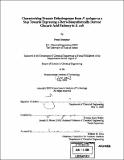Characterizing uronate dehydrogenase from P. syringae as a step towards expressing a retro-biosynthetically derived glucaric acid pathway in E. coli
Author(s)
Iranpour, Pooya
DownloadFull printable version (2.077Mb)
Other Contributors
Massachusetts Institute of Technology. Dept. of Chemical Engineering.
Advisor
Kristala Jones Prather.
Terms of use
Metadata
Show full item recordAbstract
Retro-biosynthesis is a novel pathway design method that integrates biocatalysis (in particular, functional group specificity and reactivity of enzymes) and organic chemistry. Using this method, several novel pathways have been designed in this laboratory for the microbial production of glucaric acid. In addition to design, efforts have been made in order to express these pathways inside E. col. For the production of glucaric acid in E. coil, toxicity of this organic acid as well as the uptake efficiency of glucose, the starting substrate, when in the presence of glucaric acid was assessed. Furthermore, a benchmark pathway for glucaric acid production that utilizes known reaction steps from different source organisms was designed. The design and expression of this pathway will be compared to the retro-biosynthetic pathway. The ease of design and expression will be analyzed in order to confirm the validity of retro-biosynthesis. Toxicity results showed that glucaric acid concentrations, up to 40 mM, do not affect growth of E. coli DH1OB cells. Furthermore, cells take up equal amounts of glucose even when glucaric acid is available, indicating that glucose is preferentially utilized by cells and that glucaric acid, once produced by cells, would not affect further production. (cont.) Finally, efforts have been made in order to express the benchmark pathway in E. coli. The entire pathway requires expression of three enzymes. The final reaction step requires uronate dehydrogenase in order to convert glucuronic acid to the desired product, glucaric acid. Although the function and approximate molecular weight of uronate dehydrogenase is known, its DNA sequence is not. Isolating the gene encoding the enzyme can be facilitated by a partial digestion of the genomic DNA of the source organism, P. syringae. A screening method for uronate dehydrogenase activity has also been developed and optimized. Using this screening method, the library was constructed in E. coli. Once colonies that contain uronate dehydrogenase are selected, this enzyme's sequence can be determined and the benchmark pathway can be closer to becoming expressed.
Description
Thesis (S.M.)--Massachusetts Institute of Technology, Dept. of Chemical Engineering, 2006. Includes bibliographical references (p. 48-49).
Date issued
2006Department
Massachusetts Institute of Technology. Department of Chemical EngineeringPublisher
Massachusetts Institute of Technology
Keywords
Chemical Engineering.